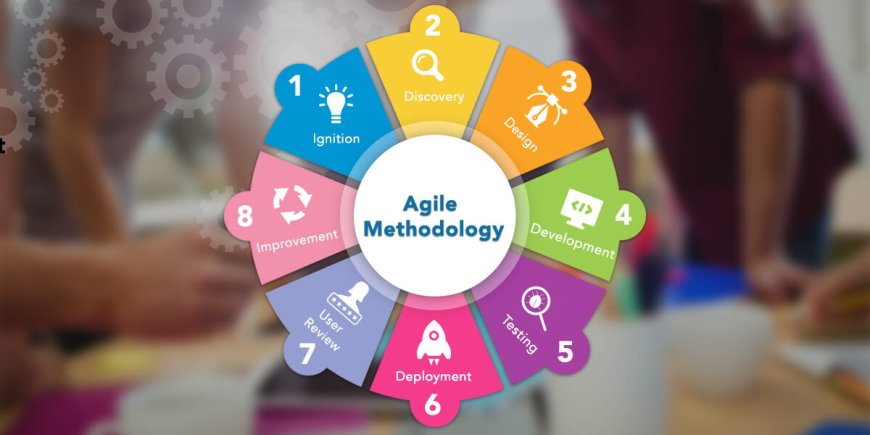Agile Methodology for Mobile Application Development
Discover how Agile methodology enhances mobile app development through flexibility, faster delivery, and continuous feedback. Learn how it benefits Android, iOS, cross-platform, Flutter, React Native, and eCommerce app development.

In the digital era, mobile applications have become an essential part of every business strategy. But developing a mobile app that meets market demands and adapts quickly to user feedback requires more than just technical skillsit requires the right development approach. This is where Agile methodology proves its worth.
Unlike traditional development models that deliver software at the end of a lengthy cycle, Agile focuses on continuous delivery, collaboration, and flexibility. For businesses aiming to stay ahead of the curve, especially in mobile app development, Agile offers a way to release high-quality apps faster, with better alignment to user needs.
In this blog, we'll explore the principles of Agile, how it fits into modern mobile development workflows, and why its the preferred choice for creating scalable, user-centric mobile applications.
What is Agile Methodology?
Agile methodology is a project management and software development framework that breaks down work into smaller iterations, known as sprints. Each sprint typically spans 14 weeks and results in a functional deliverable. Rather than waiting until the end of a long development cycle to release the final product, Agile allows for ongoing improvements and feature releases throughout the development process.
This iterative model has transformed the way softwareespecially mobile appsis built. It promotes constant collaboration, customer feedback, and adaptive planning. Teams using Agile are better equipped to respond to changes and market demands in real-time.
Why Agile Works for Mobile Application Development
Mobile apps require frequent updates, user-centric designs, and seamless performance. Agile provides a framework to build and deliver apps with these traits baked in from the beginning.
1. Faster Time to Market
Agiles sprint-based structure enables development teams to release core features quickly. This is critical in the competitive world of mobile app development, where timing can determine success. You dont have to wait months to see a working productAgile allows you to launch an MVP (Minimum Viable Product) early and build on it.
2. Continuous Feedback and Improvements
Mobile apps are used by real people in real situations. User feedback is crucial. Agile encourages ongoing testing and feedback, ensuring that improvements are implemented throughout the development cycle. This responsiveness enhances user satisfaction and app quality.
3. Better Risk Management
Agile reduces the risk of project failure. With frequent reviews, retrospectives, and testing in each sprint, bugs and misaligned features are identified early and corrected quickly. You dont risk investing months into features users may not want.
Agile in Android and iOS App Development
When it comes to platform-specific development, Agile brings unique advantages to both Android and iOS ecosystems.
Android Development with Agile
Android app development requires attention to a wide variety of device types, screen sizes, and OS versions. Agile makes it easier to test across these variables incrementally, instead of all at once at the end. This leads to better device compatibility and performance optimization throughout the project.
Agile also complements Androids modular development environment, where features and UI components can be built and tested independently.
Agile for iOS Projects
In iOS app development, Agiles value lies in helping teams stay compliant with Apple's evolving design guidelines and App Store policies. With Agile, developers can make quick changes based on Apple's feedback or system updates without affecting the entire app structure.
Regular builds, user testing with TestFlight, and version control ensure apps are optimized for performance, security, and user experience.
Cross Platform Development in Agile
For businesses looking to launch apps on both Android and iOS without doubling the development effort, cross platform app development is an effective solution. Agile aligns perfectly with cross-platform frameworks because it allows teams to:
-
Share a single codebase for both platforms
-
Test and release updates simultaneously
-
Ensure consistent design and functionality across devices
Cross-platform development using Agile sprints leads to faster deployment, reduced costs, and better control over timelines. It also simplifies collaboration between UI designers, developers, and QA teams, as all stakeholders are working toward the same goal in each sprint.
Agile with Flutter and React Native
Two of the most popular cross-platform frameworks todayFlutter and React Nativework exceptionally well with Agile methodology.
Flutter + Agile
Flutter app development benefits immensely from Agiles flexibility. Flutters hot reload feature allows developers to instantly apply code changes and view results in real time. This accelerates testing, refinement, and client approvals, which fits the short development cycles of Agile.
Flutters widget-based UI system also makes it easy to reuse code and iterate on visual components during each sprintsaving time and improving design accuracy.
React Native + Agile
In React Native app development, Agile empowers teams to build modular, scalable mobile applications with shared logic and components. React Natives fast refresh feature enables immediate updates, enhancing collaboration during sprints.
Agile supports rapid experimentation, enabling developers to introduce, test, and modify features while keeping the app stable and aligned with business goals.
eCommerce App Development with Agile
For retailers and digital commerce businesses, eCommerce app development needs to be quick, user-centric, and adaptable. Seasonal sales, changing customer behavior, and emerging trends all require frequent updates.
Agile allows eCommerce teams to:
-
Release features like flash sales, push notifications, and product updates rapidly
-
Test new promotions or layouts in controlled sprints
-
Analyze user interactions and pivot strategies based on live data
By adopting Agile, businesses ensure their app remains relevant and competitive in the fast-moving world of digital commerce.
Key Benefits of Agile in Mobile App Projects
Lets take a deeper look at the tangible benefits of applying Agile methodology to mobile app projects:
1. Increased Transparency
Agile promotes daily check-ins, sprint planning, and progress tracking. This keeps clients, developers, and stakeholders informed and aligned throughout the project.
2. Higher Quality Deliverables
With testing and validation embedded into each sprint, the quality of the product improves continuously. Bugs and usability issues are addressed early, reducing post-launch problems.
3. Improved Customer Satisfaction
Since Agile incorporates feedback throughout the development lifecycle, the final product is much more likely to meet user expectations and business goals.
4. Scalable and Future-Ready
Apps built with Agile are easier to scale and upgrade. Whether you want to introduce AI, integrate APIs, or expand functionality, Agiles modular development allows for seamless growth.
Agile Workflow: What Does It Look Like?
Heres a typical Agile workflow for a mobile app project:
-
Project Planning Define vision, goals, and key features.
-
Product Backlog Create a list of prioritized tasks.
-
Sprint Planning Select tasks to be completed in the sprint.
-
Daily Stand-ups Short team meetings to discuss progress and blockers.
-
Development & Testing Build, test, and refine during the sprint.
-
Sprint Review Showcase completed features to stakeholders.
-
Sprint Retrospective Analyze what went well and what can improve.
-
Repeat Move on to the next sprint with new goals.
Conclusion
Agile methodology has become the foundation of modern mobile application development for good reason. It enables teams to adapt, evolve, and deliver products that are in sync with real-world user needs. Agile empowers developers to build quickly, test frequently, and iterate based on feedback, ensuring that the final app is both functional and user-friendly.
Whether you're focusing on Android app development, iOS app development, or building cross-platform solutions using Flutter or React Native, Agile supports flexibility and quality at every stage. And if youre in the business of retail or digital sales, eCommerce app development with Agile offers the speed and responsiveness needed to stay ahead of market trends.
In a mobile-driven world, agility isnt just an advantageits a necessity. Adopting Agile ensures your app remains relevant, resilient, and ready for the future.





































